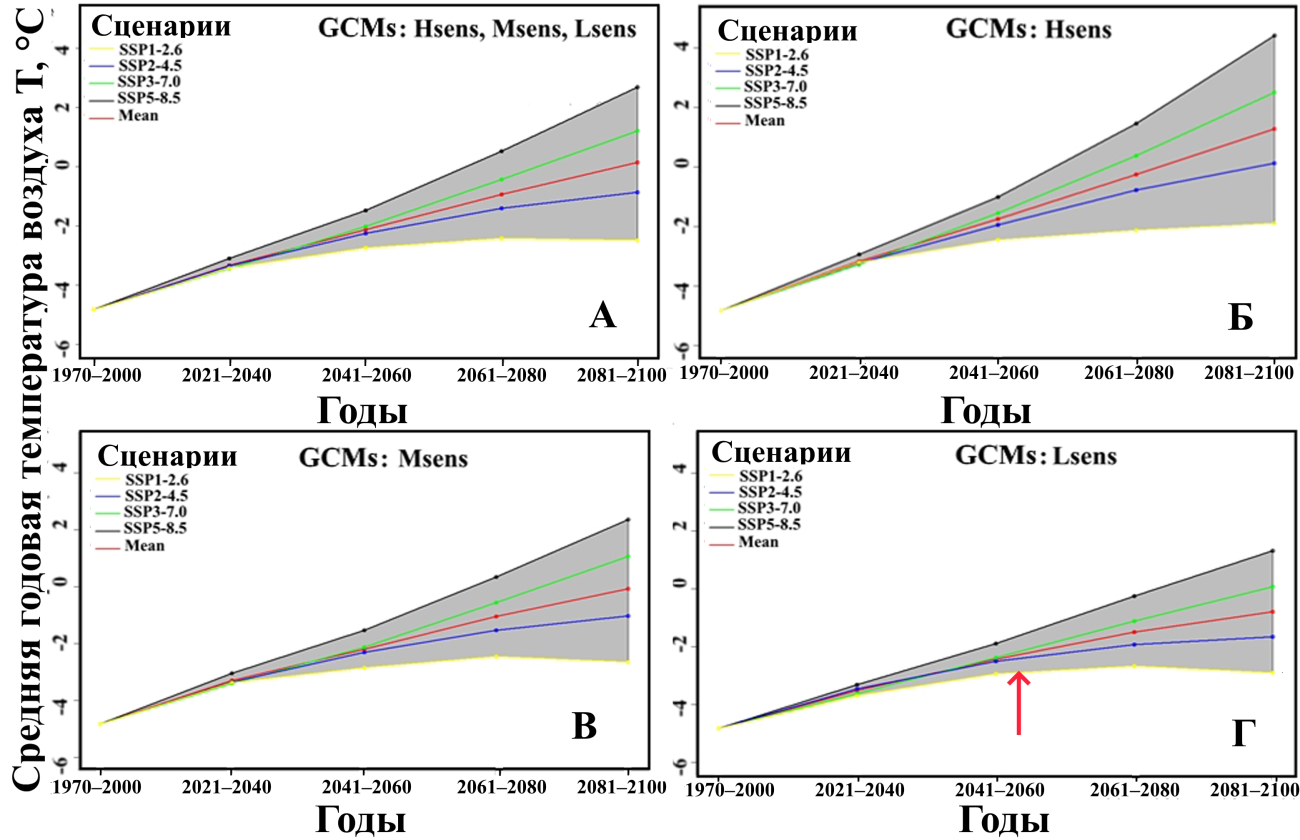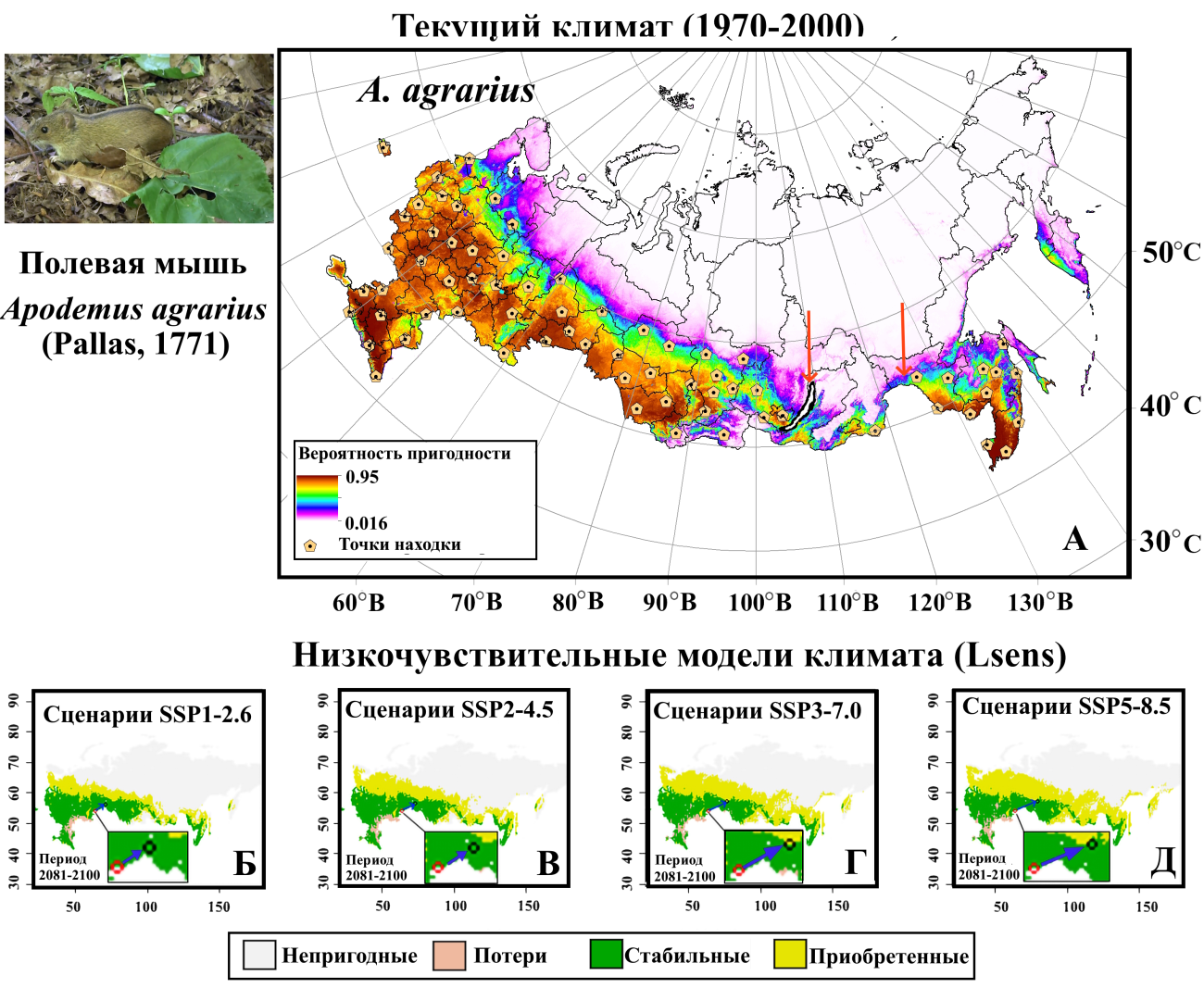Scientists from the A. N. Severtsov Institute of Ecology and Evolution of the Russian Academy of Sciences (Moscow) with colleagues from the University of Tennessee (USA) for the first time predicted the consequences of the impact of global climate change in the next 80 years on the dynamics of the range of invasive species using the example of the field mouse (Apodemus agrarius Pallas, 1771) in Russia. The species is widespread in Eurasia and common in many regions, damages agricultural crops and is a carrier of zoonotic pathogens that are dangerous to humans. Among them is hemorrhagic fever with renal syndrome, which is characterized by a high mortality rate in the Far East. Expansion of the species' range now and under future climate change may have negative impacts on the economy and public health. This study used an ensemble approach to generate robust models of the species' spatial distribution under current (1970–2000) and future climate conditions derived from sixth generation global climate change models (GMCM-6). To model the time-varying range of the field mouse, high-, moderate-, and low-sensitivity GMIC-6 were used under four scenarios (SSP1-2.6, SSP2-4.5, SSP3-7.0, and SSP5-8.5). For the first time, it is shown that among the forty GMIC-6, there is a group of models that are more consistent with real field data for the period 1980–2020. For these models, moderate warming is expected over the next two decades of the 21st century, i.e. an increase in temperature (dT) for the periods 2021–2040 and 2041–2060 will be less than 2.0 °C (dT = 1.13 °C, dT = 1.89 °C, respectively) (Fig. 1). Warming for the period 2061–2080 may be 2.15 °C, but after CO2 emissions drop to zero (around 2075), the increase in average annual air temperature for the period 2081–2100 will increase to 1.93 °C.

For each type of GMIC-6 and each of the four scenarios (SSP1-2.6, SSP2-4.5, SSP3-7.0 and SSP5-8.5), models of the geographical range of the field mouse were built for the periods 2021–2040, 2041–2060, 2061–2080 and 2081 –2100 and the positions of the centroids of the area were determined. It has been established that range changes depend on both the sensitivity of GMIC and climate change scenarios. It is shown that in the future the range of the field mouse is expected to expand with a major shift to the northeast and partial loss of habitats in the modern steppe zone. In addition, the models show the merging of the western and eastern parts of the mouse range, isolated for 12 thousand years until the present, i.e. the formation of a continuous range of the field mouse is expected from Western Europe to East Asia (Fig. 2).

It is important to note that warming in the 20th century by 0.78 °C has already led to a shift in the range of many species (about 1,700 species from different taxa are documented) to the north at a rate of 6.1 km per decade, while warming in the 21st century by 2 °C will lead to a shift in the centroid of the species' range to the north at a rate of 32 to 36 km per decade.
In general, the research carried out and the prediction of the spread of the field mouse under conditions of climate change can help to take timely measures to limit the invasion of the species and the possibility of introducing infectious diseases into new regions of Russia. At the moment, there are over 40 different climate change models in the world and 4 scenarios for each of them (i.e. 160 model implementations), which often give inaccurate predictions, and their data are published in highly rated scientific publications and are the basis for making decisions on measures combating global climate change in many countries. In this regard, comprehensive work was carried out to select the most realistic models of climate change in the 21st century to correctly assess its impact on the process of biological invasions of dangerous species at the global level and on Russian ecosystems.
The research was carried out with the support of the Russian Science Foundation (project No. 21-14-00123). The results were published in the international journal Biology (JCR IF 4.2; Q1-General Agricultural and Biological Sciences)
Petrosyan, V.; Dinets, V.; Osipov, F.; Dergunova, N.; Khlyap, L. Range Dynamics of Striped Field Mouse (Apodemus agrarius) in Northern Eurasia under Global Climate Change Based on Ensemble Species Distribution Models. Biology 2023, 12, 1034. https://doi.org/10.3390/biology12071034
Materials on the topic in the media:
Press service of the Russian Science Foundation: "Climate warming will help harmful
rodents expand their range almost twice"
Press Service of the Russian Academy of Sciences: “Climate warming will help harmful
rodents expand their range almost twice”
GAZETA.RU: “It has been established how the habitat of field mice in Russia will increase
due to global warming”
Vedomosti: "Global warming will lead to a large-scale spread of the field mouse"
Snob: "Research: Global warming will lead to the spread of the field mouse"
Sirius Magazine: "Nightmare for farmers: global warming will trigger mouse expansion"
TASS Science: "The range of rodent pests may expand by 80% due to climate change"
Internet portal "Rossiyskaya Gazeta": "Scientists have found that by the end of the century
the range of the field mouse will increase by 80 percent"
Russian popular science publication Naked Science: “Climate warming will help harmful
rodents almost double their range”
Online publication "Pravda.Ru": "Due to global warming, there is a threat of the spread of the
field mouse"
Neva.Today: “Global warming threatens a large-scale spread of harmful rodents”
News Agency "Business Information Agency": "Due to warming, Russia is threatened by the
migration of mice carrying a deadly disease"
Information portal “Moscow is changing”: “Due to global warming, harmful mice will breed”
Planet Today: "Global warming will provoke a large-scale resettlement of the field mouse"
Greencity newspaper: "Climate change may expand the distribution area of rodents"
Forpost-Sevastopol.ru: “Due to global warming, there is a threat of the spread of the field
mouse”
Agro-industrial portal AGROXXI: “Climate warming will help harmful rodents expand their
range almost twice”
Gazeta.Ru: “It has been established how the habitat of field mice in Russia will increase due
to warming”
United Europe Publishing Group: “Global warming will provoke a large-scale resettlement of
the field mouse”
Scientific and business portal “Atomic Energy 2.0”: “Climate warming will help harmful
rodents expand their range almost twice”
Polit.ru: "Field mice are advancing"
Publishing house "Arguments of the Week": "Due to climate change, the range of rodent
pests may expand by 80%"
SCIENCE OF THE RF: “Global warming will help field mice expand their range almost twice”
Central News Service: "Scientists have identified a connection between warming and the
spread of rodents"
Indicator.ru: "Climate warming will help harmful rodents expand their range almost twice"
Scientific Russia: “Climate warming will help harmful rodents expand their range almost
twice”
News Mail.RU: "Climate warming will help harmful rodents expand their range almost twice"
News Rambler.Ru: "Climate warming will help harmful rodents expand their range almost
twice"
Recyclemag: "Climate change could expand the range of rodent pests by 80%"
MK: “Due to warming, Russia is threatened by the migration of mice carrying a deadly
disease”
InScience: "Climate warming will help harmful rodents almost double their range"
